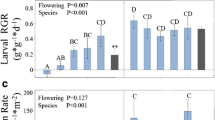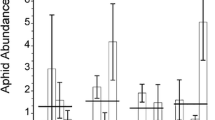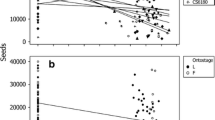Abstract
The thale cress, Arabidopsis thaliana, is considered to be an important model species in studying a suite of evolutionary processes. However, the species has been criticized on the basis of its comparatively small size at maturity (and consequent limitations in the amount of available biomass for herbivores) and on the duration and timing of its life cycle in nature. In the laboratory, we studied interactions between A. thaliana and the cabbage butterfly, Pieris rapae, in order to determine if plants are able to support the complete development of the herbivore. Plants were grown in pots from seedlings in densities of one, two, or four per pot. In each treatment, one, two, or five newly hatched larvae of P. rapae were placed on fully developed rosettes of A. thaliana. In a separate experiment, the same densities of P. rapae larvae were reared from hatching on single mature cabbage (Brassica oleracea) plants. Pupal fresh mass and survival of P. rapae declined with larval density when reared on A. thaliana but not on B. oleracea. However, irrespective of larval density and plant number, some P. rapae were always able to complete development on A. thaliana plants. A comparison of the dry mass of plants in different treatments with controls (= no larvae) revealed that A. thaliana partially compensated for plant damage when larval densities of P. rapae were low. By contrast, single cress plants with 5 larvae generally suffered extensive damage, whereas damage to B. oleracea plants was negligible. Rosettes of plants that were monitored in spring, when A. thaliana naturally grows, were not attacked by any insect herbivores, but there was often extensive damage from pulmonates (slugs and snails). Heavily damaged plants flowered less successfully than lightly damaged plants. Small numbers of generalist plant-parasitic nematodes were also recovered in roots and root soil. By contrast, plants monitored in a sewn summer plot were heavily attacked by insect herbivores, primarily flea beetles (Phyllotreta spp.). These results reveal that, in natural populations of A. thaliana, there is a strong phenological mismatch between the plant and most of its potential specialist insect herbivores (and their natural enemies). However, as the plant is clearly susceptible to attack from non-insect generalist invertebrate herbivores early in the season, these may be much more suitable for studies on direct defense strategies in A. thaliana.



Similar content being viewed by others
References
Agrawal AA (2002) Herbivory and maternal effects: Mechanisms and consequences of transgenerational induced plant resistance. Ecology 83:3408–3415
Agrawal AA (2005) Future directions in the study of induced plant responses to herbivory. Entomol Exp Appl 115:97–105
Agrawal AA, Strauss SY, Stout MJ (1999) Costs of induced responses and tolerance to herbivory in male and female fitness components of wild radish. Evolution 53:1093–1104
Agrawal AA, Conner JK, Johnson MTJ, Wallsgrove R (2002) Ecological genetics of an induced plant defense against herbivores: Additive genetic variance and costs of phenotypic plasticity. Evolution 56:2206–2213
Agerbirk N, Olsen CE, Nielsen JK (2001) Seasonal variation in leaf glucosinolates and insect resistance in two types of Barbarea vulgaris ssp. arcuata. Phytochemistry 58:91–100
Agerbirk N, Orgaard M, Nielsen JK (2003) Glucosinolates, flea beetle resistance, and leaf pubescence as taxonomic characters in the genus Barbarea (Brassicaceae). Phytochemistry 64:1177–1177
Arany AM, de Jong TJ, van der Meijden E (2005) Herbivory and abiotic factors affect population dynamics of Arabidopsis thaliana in a sand dune area. Plant Biol 7:549–555
Benrey B, Callejas A, Rios L, Oyama K, Denno RF (1998) The effects of domestication of Brassica and Phaseolus on the interaction between phytophagous insects and parasitoids. Biol Cont 11:130–140
Bodnaryk RP (1992) Effects of wounding on glucosinolates in the cotyledons of oilseed rape and mustard. Phytochemistry 31:2671–2677
Cipollini D (2002) Variation in the expression of chemical defenses in Alliaria petiolata (Brassicaceae) in the field and common garden. Am J Bot 89:1422–1430
Cipollini D (2004) Stretching the limits of plasticity: Can a plant defend against both competitors and herbivores? Ecology 85:28–37
De Vos M, Van Oosten VR, Van Poecke RMP, Van Pelt JA, Pozo MJ, Mueller MJ, Buchala AJ, Metraux JP, Van Loon LC, Dicke M, Pieterse CMJ (2005) Signal signature and transcriptome changes of Arabidopsis during pathogen and insect attack. Mol Plant-Mic Int 18:923–937
Dicke M (1999) Are herbivore-induced plant volatiles reliable indicators of herbivore identity to foraging carnivorous arthropods? Entomol Exp Appl 91:131–142
Geervliet JBF, Verdel MSW, Snellen H, Schaub J, Dicke M, Vet LEM (2000) Coexistence and niche segregation by field populations of the parasitoids Cotesia glomerata and C. rubecula in the Netherlands: predicting field performance from laboratory data. Oecologia 124:55–63
Gingras D, Dutilleul P, Boivin G (2003) Effect of plant structure on host finding capacity of lepidopterous pests of crucifers by two Trichogramma parasitoids. Biol Cont 27:25–31
Hallett RH, Ray H, Holowchuk J, Soroka JJ, Gruber MY (2005) Bioassay for assessing resistance of Arabidopsis thaliana L. (Heynh.) to the adult crucifer flea beetle, Phyllotreta cruciferae (Goeze) (Coleoptera : Chrysomelidae). Can J Plant Sci 85:225–235
Handley R, Ekbom B, Agren J (2005) Variation in trichome density and resistance against a specialist insect herbivore in natural populations of Arabidopsis thaliana. Ecol Entomol 30:284–292
Harvey JA, van Dam NM, Gols R (2003) Interactions over four trophic levels: foodplant quality affects development of a hyperparasitoid as mediated through a herbivore and its primary parasitoid. J Anim Ecol 72:529–531
Harvey JA, Witjes LM, Wagenaar R (2004) Development of the hyperparasitoid wasp, Lysibia nana (Hymenoptera: Ichneumonidae) in a multitrophic framework. Environ Entomol 33:1488–1496
Hoffmann MH (2005) Evolution of the realized climatic niche in the genus Arabidopsis. Evolution 59:1425–1436
Karban R, Baldwin IT (1997) Induced Responses to Herbivory. University of Chicago Press, Chicago IL
Luther GC, Valenzuela HR, Defrank J (1996) Impact of cruciferous trap crops on lepidopteran pests of cabbage in Hawaii. Enviro Entomol 25:39–47
Mattiacci L, Rudelli S, Rocca BA, Genini S, Dorn S (2001) Systemically-induced response of cabbage plants against a specialist herbivore, Pieris brassicae. Chemoecology 11:167–173
Mauricio R (1998) Costs of resistance to natural enemies in field populations of the annual plant, Arabidopsis thaliana. Am Nat 151:20—28
McCaffrey JR, Harmon BL, Brown J, Davis JB (2004) Resistance of canola- quality cultivars of yellow mustard, Sinapis alba L., to the cabbage seedpod weevil, Ceutorhynchus obstrictus (Marsham). Can J Plant Sci 84:397–399
Meiners T, Wäckers F, Lewis WJ (2002) The effect of molecular structure on olfactory discrimination by the parasitoid Microplitis croceipes. Chem Sen 27:811–816
Mitchell-Olds T (2001) Arabidopsis thaliana and its wild relatives: a model system for ecology and evolution. Trends Ecol Evol 16:693–700
Oostenbrink M (1960) Estimating nematode populations by some selected methods. In: Sasser JN, Jenkins WR (eds) Nematology. University of North Carolina Press, pp. 85–102
Pickett JA, Rasmussen HB, Woodcock CM, Matthes W, Napier JA (2003) Plant stress signalling: understanding and exploiting plant-plant interactions. Biochem Soc Trans 31:123–127
Picoaga A, Cartea ME, Soengas P, Monetti L, Ordas A (2003) Resistance of kale populations to lepidopterous pests in northwestern Spain. J Econ Entomol 96:143–147
Pigliucci M (2002) Ecology and evolutionary biology of Arabidopsis (Sept. 30, 2002). In: Somerville CR, Meyerowitz AM (eds) The Arabidopsis Book. American Society of Plant Biologists, Rockville, MD, doi/10.1199/tab.0003, http://www.aspb.org/publications/arabidopsis/
Reymond P, Bodenhausen N, Van Poecke RMP, Krishnamurthy V, Dicke M, Farmer EE (2004) A conserved transcript pattern in response to a specialist and a generalist herbivore. Plant Cell 16:3132–3147
Rose F (1981) The Wild Flower Key. Frederick Warne, London, U.K.
Siemens DH, Garner SH, Mitchell-Olds T, Callaway RM (2002) Cost of defense in the context of plant competition: Brassica rapa may grow and defend. Ecology 83:505–517
Somerville C, Meyerowitz E (2003) Somerville CR, Meyerowitz EM (eds) The Arabidopsis Book. American Society of Plant Biologists, Rockville, MD, doi/10.1199/tab.0003, http://www.aspb.org/publications/arabidopsis/
Strauss SY, Watson W, Allen MT (2003) Predictors of male and female tolerance to insect herbivory in Raphanus raphanistrum. Ecology 84:2074–2082
Traw MB, Dawson TE (2002) Reduced performance of two specialist herbivores (Lepidoptera : Pieridae, Coleoptera: Chrysomelidae) on new leaves of damaged black mustard plants. Environ Entomol 31:714–722
Vallad GE, Goodman RM (2004) Systemic acquired resistance and induced systemic resistance in conventional agriculture. Crop Sci 44:1920–1934
van Dam NM, Witjes L, Svatoš A (2004) Interactions between aboveground and belowground induction of glucosinolates in two wild Brassica species. New Phytol 161:801–810
van Loon JJA, de Boer JG, Dicke M (2000) Parasitoid-plant mutualism:parasitoid attack of herbivore increases plant reproduction. Entomol Exp Appl 97:219–227
van Poecke RMP, Dicke M (2002) Induced parasitoid attraction by Arabidopsis thaliana: involvement of the octadecanoid and the salicytic acid pathway. J Exp Bot 53:1793–1799
van Poecke RMP, Dicke M (2004) Indirect defence of plants against herbivores: using Arabidopsis thaliana as a model plant. Plant Biol 6:387–401
van Poecke RMP, Posthumus MA, Dicke M (2001) Herbivore-induced volatile production by Arabidopsis thaliana leads to attraction of the parasitoid Cotesia rubecula: Chemical, behavioral and gene-expression analysis. J Chem Ecol 27:1911–1928
van der Stoel CD, van der Putten WH, Duyts H (2002) Development of a negative plant-soil feedback in the expansion zone of the clonal grass Ammophila arenaria following root formation and nematode colonization. J Ecol 90:978–988
van Driesche RG, Nunn C, Kreke N, Goldstein B, Benson J (2003) Laboratory and field host preferences of introduced Cotesia spp. parasitoids (Hymenoptera : Braconidae) between native and invasive Pieris butterflies. Biol Cont 28:214–221
Weinig C, Stinchcombe JR, Schmitt J (2003) Evolutionary genetics of resistance and tolerance to natural herbivory in Arabidopsis thaliana. Evolution 57:1270–1280
Yano S, Ohsaki N (1993) The phenology and instrinsic quality of wild crucifers that determine the community structure of their herbivorous insects. Res Pop Biol 35:151–170
Yeates GW, Bongers T, de Goede GM, Freckman DW, Georgieva SS (1993) Feeding habits in soil nematode families and genera–an outline for soil ecologists. J Nematol 25:315–331
Acknowledgements
The authors wish to thank Marcel Dicke and Joop van Loon for their comments on early drafts of the article, three anonymous referees for their comments on the submitted version, Rieta Gols for her comments and for help in the preparation of graphs, and members of the Department of Multitrophic Interactions for various ideas and suggestions.
Author information
Authors and Affiliations
Corresponding author
Rights and permissions
About this article
Cite this article
Harvey, J.A., Witjes, L.M.A., Benkirane, M. et al. Nutritional suitability and ecological relevance of Arabidopsis thaliana and Brassica oleracea as foodplants for the cabbage butterfly, Pieris rapae . Plant Ecol 189, 117–126 (2007). https://doi.org/10.1007/s11258-006-9204-6
Received:
Accepted:
Published:
Issue Date:
DOI: https://doi.org/10.1007/s11258-006-9204-6




